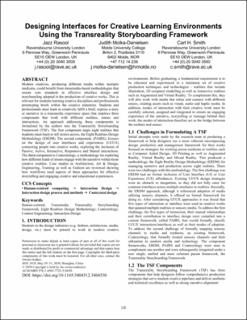| dc.contributor.author | Rasool, Jazz | |
| dc.contributor.author | Molka-Danielsen, Judith | |
| dc.contributor.author | Smith, Carl H. | |
| dc.date.accessioned | 2023-10-18T08:40:43Z | |
| dc.date.available | 2023-10-18T08:40:43Z | |
| dc.date.created | 2020-07-24T11:38:06Z | |
| dc.date.issued | 2020 | |
| dc.identifier.citation | Rasool, Jazz; Molka-Danielsen, Judith; Smith, Carl H. Designing interfaces for creative learning environments using the Transreality Storyboarding Framework. In: BDE 2020 : Proceedings of the 2020 2nd International Conference on Big Data Engineering : May 29-31, 2020, Shanghai, China, Wu, Changxu; Hwang, Kai; Liang, Yao; Kang, Dongshik (eds.), 118-125. Association for Computing Machinery (ACM) | en_US |
| dc.identifier.isbn | 978-1-4503-7722-5 | |
| dc.identifier.uri | https://hdl.handle.net/11250/3097206 | |
| dc.description.abstract | Modern creatives, producing different media within multiple mediums, could benefit from transmedia-based methodologies that ensure core standards in effective interface design and storyboarding adopted in the production of creative works. This is relevant for students learning creative disciplines and professionals prototyping briefs within the creative industries. Students and professionals must learn to creatively fulfil a brief, express a story or narrative in a transmedia experience space that employs three components that work with different realities, senses and interactions. An approach addressing these components is formalised by the authors into the Transreality Storyboarding Framework (TSF). The first component maps eight realities that students must learn to tell stories across, the Eight Realities Design Methodology (ERDM). The second component, (PAIRS), focuses on the design of user interfaces and experiences (UI/UX) connecting people into creative works, exploring the inclusion of Passive, Active, Interactive, Responsive and Shared interactions. The third component is Contextology, a methodology for exploring how different kinds of senses engage with the narrative within those creative realities. Case studies in Architecture, Art & Design, Engineering, Training as well as Fashion are reviewed showing how workflows used aspects of these approaches for effective storytelling and engaging creative and educational experiences. | en_US |
| dc.language.iso | eng | en_US |
| dc.relation.ispartof | BDE 2020 : Proceedings of the 2020 2nd International Conference on Big Data Engineering : May 29-31, 2020, Shanghai, China | |
| dc.relation.uri | https://doi.org/10.1145/3404512.3404530 | |
| dc.title | Designing interfaces for creative learning environments using the Transreality Storyboarding Framework | en_US |
| dc.type | Chapter | en_US |
| dc.description.version | publishedVersion | en_US |
| dc.source.pagenumber | 118-125 | en_US |
| dc.identifier.doi | 10.1145/3404512.3404530 | |
| dc.identifier.cristin | 1820427 | |
| cristin.ispublished | true | |
| cristin.fulltext | original | |
| cristin.qualitycode | 1 | |
